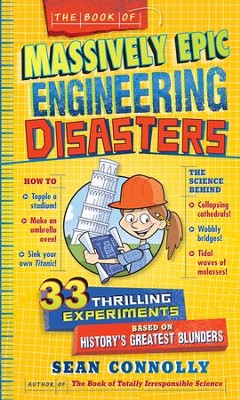
The Book of Massively Epic Engineering Disasters:
33 Thrilling Experiments Based on History's Greatest Blunders
by Sean Connolly
I wrote a blog post previously with my planning notes when doing this block on Zoom. Now I get to do it IRL with a group of students!
For each disaster I'll share my up-to-date notes and some photos. Today we learned about The Leaning Tower of Pisa (1173) and Galileo Galilei (1589).
- recall last week's disaster (Fidenae Stadium)
- read "The Leaning Tower of Pisa" information from The Book of Massively Epic Engineering Disasters, pp. 29-33
- do experiment #5 "Will It Tip?"
- for each child:
an empty 12 oz soda can
water
a level surface (tabletop, floor, etc.)
You probably also want to have on hand a roll of paper towels, just in case. As I so cleverly accidentally discovered today, this experiment does not work with a 7.5 oz can... and it was interesting for us to hypothesize why! The proportions of it are quite different from those of a 12 oz. can.
I also thought of another fun thing to do. When I was chatting with them and explaining center of mass, I balanced a gel pen on my fingertip by moving the location of the pen in relation to my finger. But would it be possible to not move my finger and instead use clay to add mass to different areas of the pen until it balanced?
That would be more like what they had to do with the Tower of Pisa, since you can't easily relocate a building like you can move a pen about.
- read "Seeing Isn't Believing" information about Galileo Galilei from Mathematicians Are People, Too: Stories from the Lives of Great Mathematicians by Luetta and Wilbert Reimer, pp. 45-49
- do Showing Science: Watch Objects in Free Fall experiment from Scientific American
trial 1: golf ball, plastic perforated practice golf ball
these balls are the exact same size but different masses... but the wind blew through the holes in the plastic perforated practice ball and pushed it sideways and slowed it down (next time, I will get a foam practice golf ball)
trial 2: golf ball, basketball
the children really wanted try this again with a large ball and a small ball... unfortunately, I didn't have two balls of different sizes but the same mass... and they also did not hit the ground at the same time
- recall that Galileo devised his famous Leaning Tower of Pisa experiment after making observations about pendulums (a pendulum with a larger weight does NOT swing faster than a pendulum with a smaller weight)
- do some pendulum explorations
- for each team (set up two):
ball of string
scissors
S-hook
lots of metal washers of different sizes
stopwatch that measures fractions of a second
piece of chalk & stepstool (if using a chalkboard)
optional: a balance (which the teams can share) to measure the mass
The last time we did this was back in 2017!

Again, I taped a stick to the top of my chalkboard and had the children use it. This time we had teams working on either side of the chalkboard. A chalkboard is nice for this because it can hold your data table PLUS you can simply put a tickmark with chalk on it at the place where you are letting the pendulum go!
They found, just as Galileo discovered, that the only thing that makes a difference is the length of the string.
I think that because it is easier to see that a heavier weight does not fall faster in the pendulum experiment that it is better to do with kids than the "dropping two things out the window" experiment. However, dropping two things out the window is extremely fun! Maybe next time I will try a raw egg and a wooden egg... or a plastic egg... or I could needle felt a wool egg.

this is the time of year to buy fake eggs!
Actually, plastic Easter eggs would probably be the very best idea because you could have the children fill them with different things to create different weights. Then tape or glue them closed. That would be very exciting. I do recommend taking the video of the items hitting the ground, as it is very hard to tell with the naked eye. Today I thought the basketball hit first, but that was because the golf ball was already bouncing back up into the air by the time the basketball arrived at the ground.
- pass out Science Club notebooks, have each child draw and write notes about his/her favorite experiment or about the disaster itself
This post contains affiliate links to materials I truly use for homeschooling. Qualifying purchases provide me with revenue. Thank you for your support!















 Immersive Experience
Immersive Experience Immersive Experience
Immersive Experience







No comments:
Post a Comment